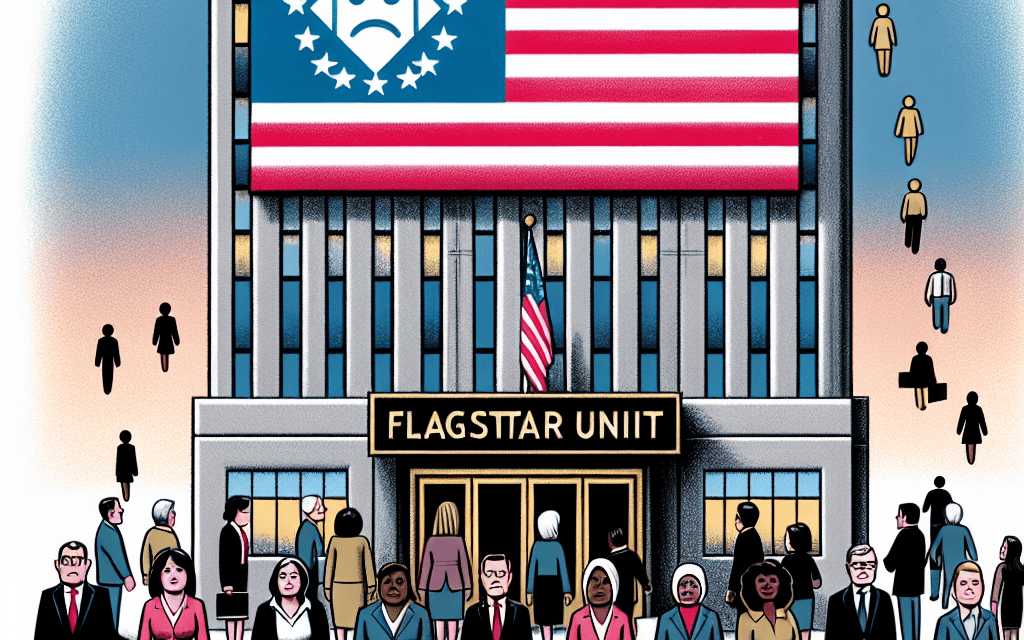“Flagstar Unit of NYCB: Streamlining Operations, Impacting Lives.”
Introduction
Flagstar Bank, a unit of New York Community Bancorp (NYCB), has announced plans to eliminate approximately 1,900 positions, a move that reflects ongoing adjustments within the banking sector. This decision comes as part of a strategic effort to streamline operations and enhance efficiency following NYCB’s acquisition of Flagstar Bancorp. The job cuts are expected to impact various departments and are aimed at reducing redundancies and aligning the workforce with the bank’s current business objectives. This restructuring initiative underscores the challenges faced by financial institutions in adapting to changing market conditions and technological advancements.
Impact Of Job Cuts On Flagstar’s Operational Efficiency
The recent announcement by Flagstar Bank, a unit of New York Community Bancorp (NYCB), to eliminate approximately 1,900 positions has sparked significant discussions regarding its impact on the bank’s operational efficiency. This decision, while undoubtedly challenging for those affected, is part of a broader strategy aimed at streamlining operations and enhancing the bank’s competitive edge in a rapidly evolving financial landscape. As the banking industry continues to face pressures from technological advancements and changing consumer preferences, institutions like Flagstar are compelled to reassess their operational frameworks to maintain profitability and relevance.
In the context of operational efficiency, the reduction in workforce can be seen as a double-edged sword. On one hand, it presents an opportunity for Flagstar to reduce costs significantly. Labor expenses constitute a substantial portion of a bank’s operational costs, and by trimming its workforce, Flagstar can potentially allocate resources more effectively. This reallocation could enable the bank to invest in technology and infrastructure that enhance service delivery and customer experience. Moreover, with fewer employees, the bank might streamline its decision-making processes, leading to quicker responses to market changes and customer needs.
On the other hand, the reduction in workforce poses challenges that Flagstar must navigate carefully to avoid adverse effects on its operational efficiency. The loss of experienced personnel could lead to a temporary dip in productivity as remaining employees adjust to new roles and responsibilities. Additionally, the morale of the workforce could be impacted, potentially affecting employee engagement and performance. To mitigate these risks, Flagstar will need to implement robust transition plans, including retraining programs and support systems, to ensure that the remaining workforce is well-equipped to handle the increased workload and maintain service quality.
Furthermore, the decision to cut jobs must be aligned with a strategic vision that prioritizes long-term growth and sustainability. Flagstar’s leadership will need to communicate transparently with stakeholders, including employees, customers, and investors, to maintain trust and confidence in the bank’s future direction. By articulating a clear rationale for the job cuts and outlining the anticipated benefits, Flagstar can foster a sense of shared purpose and commitment among its stakeholders.
In addition to internal adjustments, Flagstar must also consider the external implications of its workforce reduction. The banking industry is highly competitive, and customer expectations are continually evolving. As such, Flagstar must ensure that its operational efficiency gains translate into tangible improvements in customer service and product offerings. By leveraging technology and innovation, the bank can enhance its digital platforms, streamline processes, and offer personalized solutions that meet the diverse needs of its clientele.
In conclusion, while the elimination of approximately 1,900 positions at Flagstar Bank presents immediate challenges, it also offers an opportunity to enhance operational efficiency and position the bank for future success. By carefully managing the transition and aligning its strategy with market demands, Flagstar can navigate this period of change effectively. Ultimately, the bank’s ability to balance cost reduction with service excellence will determine its success in maintaining competitiveness and achieving sustainable growth in the dynamic banking industry.
Economic Implications Of Workforce Reduction At Flagstar
The recent announcement by Flagstar Bank, a unit of New York Community Bancorp (NYCB), to eliminate approximately 1,900 positions has sent ripples through the financial sector, raising questions about the broader economic implications of such a significant workforce reduction. This decision, while primarily a strategic move to streamline operations and enhance efficiency, also reflects the ongoing challenges faced by the banking industry in adapting to a rapidly changing economic landscape. As the financial sector continues to evolve, understanding the ramifications of such workforce adjustments is crucial for stakeholders, including employees, investors, and policymakers.
To begin with, the immediate impact of the job cuts will be felt most acutely by the affected employees and their families. The loss of nearly 1,900 positions represents not only a significant reduction in Flagstar’s workforce but also a substantial number of individuals who will now face the challenges of unemployment. This development underscores the importance of robust support systems, such as unemployment benefits and job retraining programs, to assist displaced workers in transitioning to new employment opportunities. Moreover, the ripple effect of these job losses may extend beyond the individuals directly affected, potentially impacting local economies where these employees reside and contribute to economic activity.
In addition to the direct impact on employees, the decision by Flagstar Bank highlights broader trends within the banking industry. The financial sector has been undergoing a transformation driven by technological advancements, changing consumer preferences, and increased regulatory pressures. As banks strive to remain competitive, many are turning to digital solutions and automation to reduce costs and improve service delivery. Consequently, workforce reductions have become a common strategy for banks seeking to realign their operations with these new realities. While such measures may enhance efficiency and profitability in the long term, they also raise concerns about the social and economic costs of displacing workers in an industry that has traditionally been a significant source of employment.
Furthermore, the decision by Flagstar Bank may have implications for investor confidence and market perceptions of NYCB. Workforce reductions are often viewed as a sign of a company’s efforts to improve its financial health and operational efficiency. However, they can also signal underlying challenges that may affect future performance. Investors will be closely monitoring how NYCB navigates this transition and whether the anticipated cost savings translate into improved financial results. Additionally, the bank’s ability to maintain customer satisfaction and service quality amid these changes will be critical in sustaining its competitive position in the market.
On a broader scale, the workforce reduction at Flagstar Bank serves as a reminder of the need for policymakers to address the structural changes occurring within the financial sector. As banks continue to adapt to new technologies and market conditions, there is a growing need for policies that support workforce development and ensure that employees have the skills necessary to thrive in a digital economy. This includes investing in education and training programs that equip workers with the competencies required for emerging roles in the financial sector.
In conclusion, the elimination of approximately 1,900 positions at Flagstar Bank is a significant development with far-reaching economic implications. While it reflects the bank’s strategic efforts to enhance efficiency, it also highlights the challenges faced by employees and the broader industry in adapting to a rapidly changing environment. As the financial sector continues to evolve, it is essential for stakeholders to consider the social and economic impacts of such workforce adjustments and to work collaboratively towards solutions that support both business objectives and employee well-being.
Strategies For Employees Affected By Flagstar’s Layoffs
The recent announcement by Flagstar Bank, a unit of New York Community Bancorp (NYCB), to eliminate approximately 1,900 positions has sent ripples of concern through the workforce. As employees grapple with the uncertainty of job loss, it becomes imperative to explore strategies that can help navigate this challenging transition. Understanding the broader context of these layoffs is crucial, as it allows affected individuals to better prepare for the changes ahead. The decision to reduce the workforce is often driven by a need to streamline operations, cut costs, or adapt to shifting market conditions. While these reasons may offer some insight into the company’s actions, they do little to alleviate the immediate concerns of those facing unemployment.
In light of these developments, employees must adopt a proactive approach to manage the impact of job loss. One of the first steps is to thoroughly review any severance packages or benefits offered by the company. Understanding the financial support available can provide a temporary cushion and help in planning the next steps. Additionally, it is advisable to explore unemployment benefits and other government assistance programs that may be available. These resources can offer crucial support during the transition period and help mitigate financial strain.
Networking emerges as a vital strategy for those affected by layoffs. Reaching out to former colleagues, industry contacts, and professional associations can open doors to new opportunities. Engaging in networking events, both in-person and online, can expand one’s professional circle and increase the likelihood of finding new employment. Moreover, leveraging platforms such as LinkedIn to showcase skills and experience can enhance visibility to potential employers.
Simultaneously, this period of transition presents an opportunity for personal and professional growth. Employees can consider upskilling or reskilling to align with current industry demands. Online courses, workshops, and certifications can provide valuable knowledge and make candidates more competitive in the job market. By investing in skill development, individuals not only enhance their employability but also demonstrate adaptability and a commitment to continuous learning.
Furthermore, maintaining a positive mindset is essential during this challenging time. While the prospect of job loss can be daunting, it is important to focus on the potential for new beginnings. Setting realistic goals and maintaining a structured routine can provide a sense of purpose and direction. Engaging in activities that promote mental and physical well-being, such as exercise, meditation, or hobbies, can also help alleviate stress and foster resilience.
In addition to personal strategies, seeking professional guidance can be beneficial. Career counseling services can offer tailored advice and support, helping individuals identify strengths and explore new career paths. Resume writing services and interview coaching can also enhance job search efforts, ensuring that candidates present themselves effectively to potential employers.
Ultimately, while the elimination of positions at Flagstar Bank presents significant challenges, it also offers an opportunity for reinvention and growth. By adopting a proactive approach, leveraging available resources, and maintaining a positive outlook, employees can navigate this transition successfully. As the job market continues to evolve, those affected by layoffs can emerge stronger and more resilient, ready to embrace new opportunities and chart a path forward.
Analyzing The Financial Health Of NYCB Post-Flagstar Layoffs

The recent announcement by Flagstar Bank, a unit of New York Community Bancorp (NYCB), to eliminate approximately 1,900 positions has sparked significant discussion regarding the financial health of NYCB. This decision, while undoubtedly difficult, is part of a broader strategy to streamline operations and enhance efficiency in a challenging economic environment. As the banking industry continues to evolve, institutions like NYCB must adapt to remain competitive and financially robust.
To understand the implications of these layoffs, it is essential to consider the broader context in which NYCB operates. The banking sector has been under pressure from various fronts, including fluctuating interest rates, regulatory changes, and the rapid advancement of financial technology. These factors have compelled banks to reassess their operational models and cost structures. In this light, the decision by Flagstar to reduce its workforce can be seen as a proactive measure to align its resources with its strategic objectives.
Moreover, the integration of Flagstar into NYCB, following their merger, presents both opportunities and challenges. On one hand, the merger offers the potential for increased market share and expanded service offerings. On the other hand, it necessitates the harmonization of operations, which can lead to redundancies. The elimination of positions, therefore, may be a necessary step to eliminate overlaps and achieve the desired synergies from the merger.
Financially, NYCB’s decision to implement these layoffs could result in significant cost savings. By reducing its workforce, the bank can lower its operating expenses, which is crucial in maintaining profitability, especially in a low-interest-rate environment where margins are compressed. These savings can then be redirected towards investments in technology and innovation, areas that are increasingly critical for banks to remain competitive. Furthermore, by optimizing its cost structure, NYCB can improve its financial ratios, which are closely monitored by investors and analysts.
However, it is important to acknowledge the potential risks associated with such a significant reduction in workforce. Layoffs can impact employee morale and productivity, which in turn can affect customer service and satisfaction. NYCB must therefore ensure that it manages this transition carefully, providing support to affected employees and maintaining clear communication with its remaining workforce. Additionally, the bank must continue to focus on its customer-centric approach, ensuring that service quality is not compromised during this period of change.
In conclusion, while the decision by Flagstar, a unit of NYCB, to eliminate approximately 1,900 positions is a significant development, it is a strategic move aimed at strengthening the bank’s financial health. By streamlining operations and reducing costs, NYCB is positioning itself to navigate the challenges of the banking industry more effectively. Nevertheless, the bank must balance these operational efficiencies with a commitment to maintaining high standards of service and employee engagement. As NYCB moves forward, its ability to adapt to the evolving financial landscape while staying true to its core values will be key to its long-term success.
The Role Of Automation In Flagstar’s Workforce Reduction
The recent announcement by Flagstar Bank, a unit of New York Community Bancorp (NYCB), to eliminate approximately 1,900 positions has sparked significant discussion regarding the role of automation in workforce reductions. As industries across the globe increasingly integrate advanced technologies into their operations, the banking sector is no exception. Automation, in particular, has emerged as a pivotal force reshaping the landscape of employment within financial institutions. This development at Flagstar Bank serves as a pertinent example of how automation is influencing staffing decisions and operational strategies.
To understand the implications of this workforce reduction, it is essential to consider the broader context of automation in the banking industry. Over the past decade, banks have been progressively adopting automated systems to enhance efficiency, reduce costs, and improve customer service. Technologies such as artificial intelligence, machine learning, and robotic process automation have enabled banks to streamline processes that were traditionally labor-intensive. For instance, tasks such as data entry, transaction processing, and customer inquiries can now be handled with minimal human intervention, allowing banks to allocate resources more effectively.
In the case of Flagstar Bank, the decision to cut approximately 1,900 positions can be seen as a strategic move to align with the evolving technological landscape. By leveraging automation, the bank aims to optimize its operations and remain competitive in an industry that is rapidly transforming. While this transition may lead to short-term challenges for affected employees, it is also indicative of a broader trend where banks are re-evaluating their workforce needs in light of technological advancements.
Moreover, the integration of automation within Flagstar Bank is likely to result in several long-term benefits. For one, automation can significantly reduce operational costs by minimizing the need for manual labor and decreasing the likelihood of human error. This cost efficiency can, in turn, be passed on to customers in the form of lower fees and improved services. Additionally, automation can enhance the speed and accuracy of banking operations, leading to a more seamless customer experience. As banks strive to meet the growing expectations of tech-savvy consumers, the ability to offer quick and reliable services becomes increasingly crucial.
However, it is important to acknowledge the potential downsides of automation-driven workforce reductions. The displacement of employees poses significant challenges, not only for those directly affected but also for the broader community. As jobs are eliminated, there is a pressing need for reskilling and upskilling initiatives to help workers transition into new roles within or outside the banking sector. This underscores the importance of collaboration between financial institutions, educational entities, and government bodies to develop programs that support workforce adaptation in the face of technological change.
In conclusion, the decision by Flagstar Bank to eliminate approximately 1,900 positions highlights the growing influence of automation in shaping workforce dynamics within the banking industry. While automation offers numerous advantages in terms of efficiency and cost-effectiveness, it also necessitates careful consideration of its impact on employment. As banks continue to navigate this complex landscape, a balanced approach that embraces technological innovation while supporting affected employees will be crucial in ensuring a sustainable and equitable transition.
Community Reactions To Flagstar’s Job Elimination Announcement
The recent announcement by Flagstar Bank, a unit of New York Community Bancorp (NYCB), to eliminate approximately 1,900 positions has sent ripples through the communities affected by this decision. As the news spread, various stakeholders, including employees, local businesses, and community leaders, have expressed a range of reactions, highlighting the multifaceted impact of such a significant workforce reduction.
To begin with, employees who are directly impacted by the job cuts have voiced their concerns and uncertainties about the future. Many of these individuals have dedicated years of service to the company, and the sudden announcement has left them grappling with the challenges of job searching in an uncertain economic climate. The emotional toll on these employees cannot be understated, as they face not only the loss of income but also the disruption of their professional identities and daily routines. In response, some have turned to social media platforms to share their experiences and seek support from peers, while others are exploring opportunities for retraining and upskilling to enhance their employability in a competitive job market.
Moreover, the ripple effects of the job eliminations extend beyond the individuals directly affected, impacting local economies and businesses that rely on the patronage of Flagstar employees. Small businesses, in particular, are bracing for a potential decline in revenue as a result of reduced consumer spending. Restaurants, retail stores, and service providers in the vicinity of Flagstar’s operations may experience a downturn, prompting concerns about their own financial stability. In this context, community leaders are emphasizing the importance of supporting local businesses during this challenging period, encouraging residents to shop locally and participate in initiatives aimed at bolstering the local economy.
In addition to economic concerns, the job cuts have sparked discussions about the broader implications for the banking industry and the communities it serves. Industry analysts suggest that the decision by Flagstar and NYCB may be indicative of a larger trend towards consolidation and cost-cutting within the financial sector. As banks continue to adapt to technological advancements and changing consumer preferences, workforce reductions may become more commonplace. This raises questions about the future of employment in the industry and the need for proactive measures to support workers in transition.
Community leaders and policymakers are also weighing in on the situation, calling for a coordinated response to mitigate the impact of the job losses. Some are advocating for the establishment of task forces to provide resources and assistance to affected workers, including job placement services, career counseling, and financial planning support. Additionally, there is a growing emphasis on the importance of collaboration between public and private sectors to create new employment opportunities and foster economic resilience in the face of such challenges.
In conclusion, the announcement by Flagstar Bank to eliminate approximately 1,900 positions has elicited a wide range of reactions from the community, underscoring the complex interplay between corporate decisions and their social and economic consequences. As affected individuals and communities navigate this period of uncertainty, there is a collective call for empathy, support, and strategic action to address the immediate needs of those impacted while also laying the groundwork for a more resilient future. Through collaboration and innovation, it is hoped that the community can emerge stronger and more united in the face of adversity.
Future Prospects For Flagstar And NYCB After Workforce Downsizing
The recent announcement by Flagstar Bank, a unit of New York Community Bancorp (NYCB), to eliminate approximately 1,900 positions has sent ripples through the financial sector, raising questions about the future prospects for both Flagstar and its parent company, NYCB. This significant workforce downsizing is part of a broader strategy to streamline operations and enhance efficiency in a challenging economic environment. As the banking industry grapples with evolving market dynamics, understanding the implications of such a move is crucial for stakeholders and analysts alike.
To begin with, the decision to reduce the workforce by such a substantial number is indicative of the pressures faced by financial institutions in maintaining profitability amidst fluctuating interest rates and increased regulatory scrutiny. For Flagstar, this move is not merely a cost-cutting measure but a strategic realignment aimed at positioning the bank for long-term growth. By reallocating resources and focusing on core competencies, Flagstar aims to enhance its competitive edge in a rapidly changing market landscape. This approach, while difficult, is often necessary for companies seeking to adapt to new economic realities.
Moreover, the impact of this downsizing extends beyond immediate cost savings. It reflects a broader trend within the banking industry, where technological advancements and digital transformation are reshaping traditional business models. As banks increasingly invest in digital platforms and automation, the need for a large workforce diminishes, leading to a shift in employment patterns. For Flagstar and NYCB, embracing technology-driven solutions could unlock new opportunities for growth and innovation, allowing them to better serve their customers and meet evolving demands.
In addition to technological advancements, the decision to downsize is also influenced by the need to optimize operational efficiency. By streamlining processes and eliminating redundancies, Flagstar can focus on delivering value to its clients and shareholders. This strategic focus on efficiency is crucial in an industry where margins are under constant pressure, and competition is fierce. As such, the workforce reduction can be seen as a proactive measure to ensure the bank’s sustainability and resilience in the face of economic uncertainties.
Furthermore, the implications of this workforce downsizing extend to the broader financial ecosystem. For NYCB, the parent company, this move could signal a shift in strategic priorities, with a renewed emphasis on core banking activities and a potential reevaluation of its business portfolio. By aligning its operations more closely with market demands, NYCB can enhance its market position and drive shareholder value. This strategic realignment may also open up opportunities for mergers and acquisitions, as the bank seeks to strengthen its foothold in key markets.
In conclusion, while the decision by Flagstar to eliminate approximately 1,900 positions is undoubtedly challenging for those affected, it represents a strategic pivot aimed at securing the bank’s future in a rapidly evolving industry. By focusing on efficiency, embracing technological advancements, and realigning strategic priorities, both Flagstar and NYCB are positioning themselves for sustainable growth. As the banking landscape continues to evolve, these measures will be critical in ensuring that they remain competitive and resilient in the face of ongoing challenges. Ultimately, the success of this strategy will depend on the ability of both institutions to adapt to changing market conditions and leverage new opportunities for growth and innovation.
Q&A
1. **What is happening at Flagstar Bank, a unit of NYCB?**
Flagstar Bank, a unit of New York Community Bank (NYCB), is eliminating approximately 1,900 positions.
2. **Why is Flagstar Bank eliminating these positions?**
The job cuts are part of a restructuring effort following NYCB’s acquisition of Flagstar Bancorp, aimed at streamlining operations and reducing costs.
3. **When was the acquisition of Flagstar Bancorp by NYCB completed?**
The acquisition was completed in December 2022.
4. **How many employees does Flagstar Bank have?**
Before the job cuts, Flagstar Bank had around 5,000 employees.
5. **Which areas or departments are most affected by the job cuts?**
The job cuts primarily affect the mortgage division, which has been under pressure due to rising interest rates and a slowdown in the housing market.
6. **What is the expected impact of these job cuts on Flagstar Bank’s operations?**
The job cuts are expected to help Flagstar Bank improve efficiency and focus on core banking operations, though they may also lead to short-term disruptions.
7. **How has the market reacted to the announcement of job cuts at Flagstar Bank?**
The market reaction has been mixed, with some investors viewing the cuts as a necessary step for cost management, while others express concern over potential impacts on service and growth.
Conclusion
Flagstar Bank, a unit of New York Community Bancorp (NYCB), announced plans to eliminate approximately 1,900 positions, primarily due to the integration of its operations with those of the recently acquired Signature Bank. This decision is part of a broader strategy to streamline operations and achieve cost efficiencies following the acquisition. The job cuts represent a significant reduction in workforce, aimed at consolidating overlapping roles and optimizing the combined entity’s operational structure. This move reflects the ongoing trend in the banking industry to enhance profitability through strategic mergers and workforce realignments.





